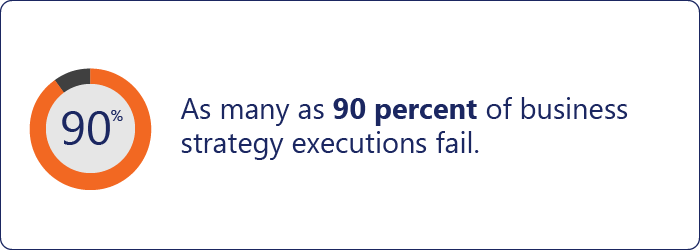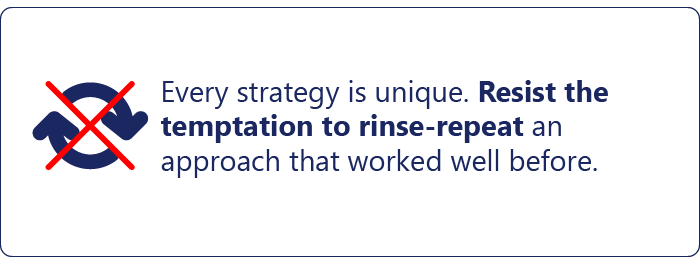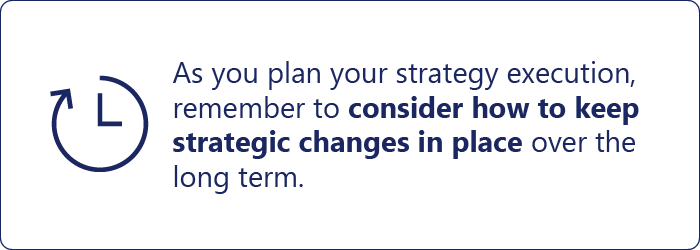5-minute read
Quick summary: Even the best corporate strategies can fail in execution—and many do. We’re sharing five proven approaches to bridging the strategy execution gap and accelerating progress towards your objectives.
“The thing that keeps a business ahead of the competition,” Tom Peters once wrote, “is excellence in execution.” While Peters’ observation is tough to argue with, how many organizations are putting it into practice? Do a Google search for “corporate strategy” and you’ll turn up over 13 million results. Search for “strategy execution” and results barely top 2 million.
Businesses across industries have devoted thousands of hours and millions of dollars to developing targeted corporate strategies for achieving their goals. Yet the strategy failure rate is staggering, up to 90 percent according to some studies.
What separates the success stories from the also-rans is what comes next—what happens after the glossy, spiral-bound strategic document is in the hands of every C-suite member. It’s the execution. How a strategy is executed means the difference between crossing the finishing line and getting stuck in the pit lane.
Over the years, we’ve built and successfully executed hundreds of strategies for clients across practice areas and across industries. With every execution, we build these five proven success factors into our approach.

Success factor #1: Build the right plan for the goal
Every strategy is unique, so when it comes to execution, it’s important to resist the temptation to rinse-repeat something that worked well before. Even if the goal is similar to that of an earlier plan, some factors will be unique. The key is to first understand what is different versus what is the same. Once you know that, it’s easy to determine the pivots and shifts that will need to take place for a successful execution.
For example, recently we built and executed marketing strategies for two divisions of the same enterprise. While some factors remained constant, it was obvious that what worked for one division would not work as-is for the other. When we began work on executing the second strategy, our team was able to leverage certain elements from the first while also taking the differences into account.

Success factor #2: Be practical
Many strategies fail because they never come down from the 10,000-foot overview of what the organization wants to accomplish. We’ve worked with numerous clients who have gone through the time and expense of bringing in strategic consultants, and all they have to show for it is a slick binder full of colorful graphs. A successful strategy execution is practical on a granular level, down to the specifics of what needs to be done, when, by whom, and according to what specifications.
Practical strategy executions are also flexible. As the adage goes, “no battle plan survives contact with the enemy,” and few strategies wind up being executed exactly as planned. Strategies tend to be developed in a vacuum, and once you get into execution, something that made perfect sense on paper might not be the best course of action. It’s important not to be too attached to the strategy document, to be willing to pivot as circumstances require and to put your own interpretation on the strategy execution.

Success factor #3. Set the team up for success
Having the right people in place and setting them up for success is essential for solid strategy execution. Here are a few best practices to keep in mind.
Create the right mix of people
Outside resources can fill in skill gaps to help you build a successful team; just make sure you match the right resources for the job. If, for example, you’re looking at a massive—but relatively straightforward—data migration, a large consulting firm can probably deliver the resources you need. If, on the other hand, you’re looking at a more complex, higher-risk undertaking, a “special forces” approach involving fewer but more deeply experienced people from a boutique firm is your best bet.
Promote a one-team mentality
If you bring in outside resources, make sure they can integrate well with your internal team and vice versa. When we send a team to execute a client’s strategy, there is no “us” and “them.” Every person views the client’s team as their team and the client’s success as their success.
Build in cross-functional collaboration
One of the benefits of partnering with a small-to-midsize consulting firm is that all the consultants know each other personally and can tap into each other’s expertise in solving problems.

Success factor #4: Think long-term
Because large-scale strategic executions can take a year or more to complete, it’s easy to overlook questions concerning what happens next. For example, …
• Who is going to manage all this after the execution is complete?
• How will we ensure that the new system/standards/practices will be followed on an ongoing basis?
• How will we monitor the results of the execution to determine ROI?
When we work with clients on strategy execution, we set them up for success over the long term. Whether that means setting up data governance guidelines or helping select people for an oversight committee, we put ownership squarely in our clients’ hands so they can ensure continued positive return on their strategic investments.

Success factor #5: Consider the total cost of ownership
In addition to considering the people, processes and resources required to maintain strategic changes over the long term, it’s also important to build the total cost of ownership into the execution plan.
Have you ever heard the proverb “Nobody is rich enough to buy cheap?” If executing the strategy at the lowest possible cost is the goal, you could wind up with gaps that lead to high-cost problems down the road.
When we execute strategies for clients, we make sure to cover all the bases—including training and long-term change management—so that when we’re done, the strategy will move seamlessly into maintenance mode. As a result, the execution may take longer than it would with a different resource, but the overall cost of ownership is dramatically lower.

Regardless of the type of strategy you’re planning, it’s important to remember that the “shiny binder” is only the beginning. Strategies, after all, don’t execute themselves. But through careful planning and thorough consideration of all the factors (obvious and not-so-obvious), you can ensure that your undertaking will deliver positive ROI over the short and long term.
Like what you see?

Mick Wagner is a Senior Solutions Architect in the Advanced Analytics practice at Logic20/20.

Evan Alkhas is a Strategy Manager at Logic20/20 with extensive knowledge in strategic development, operating models, business process optimization, and new product innovation.

